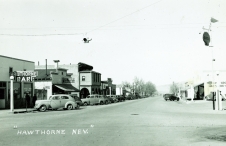Carlin
The town of Carlin emerged soon after the Central Pacific Railroad established the eastern terminus of its Humboldt Division in 1868. Even before the town was platted, a small group of Chinese railroad workers occupied the area on what is now the western border of Elko County.
By 1871, Carlin had a population of 800, with a schoolhouse, a post office, and a library. In 1884, the town had grown to support four stores, one hotel, two saloons, and one jail. Carlin remained an important railroad town until well into the 1900s.
Carlin also was the site of a rather grizzly murder-mystery case that led to the execution of a husband and wife in 1890. While investigating the sounds of what he perceived to be a ghost, George Brewer discovered a corpse in the cellar of his Carlin home. A pocketknife found on the victim helped identify the man, and the previous owners of the house, Josiah and Elizabeth Potts, became suspects. The couple was eventually found, convicted, and sentenced to death. On June 20, 1890, both were hanged. Mrs. Potts was the first woman–and last, as of the date of this writing–to be legally executed in Nevada.
In the early 1900s, ice became an important industry in Carlin, because it was the first ice-replenishing stop on the railway east of Sparks, Nevada. Ice was harvested in the winter from a man-made ice pond near Carlin and stored in well-insulated icehouses to last through the summer. The industry eventually faded away with the advent of refrigerated railroad cars, and the icehouses were gone by 1969.
During the 1960s, the discovery and subsequent development of the Carlin Trend, a massive deposit of microscopic gold, brought new life to Carlin, making it the center of one of the world's most important precious metal mining operations. The town of Carlin is very much alive today, with mining being an important industry. In 2007, the population estimate was over 2,200.
Article Locations
Related Articles
Further Reading
None at this time.



